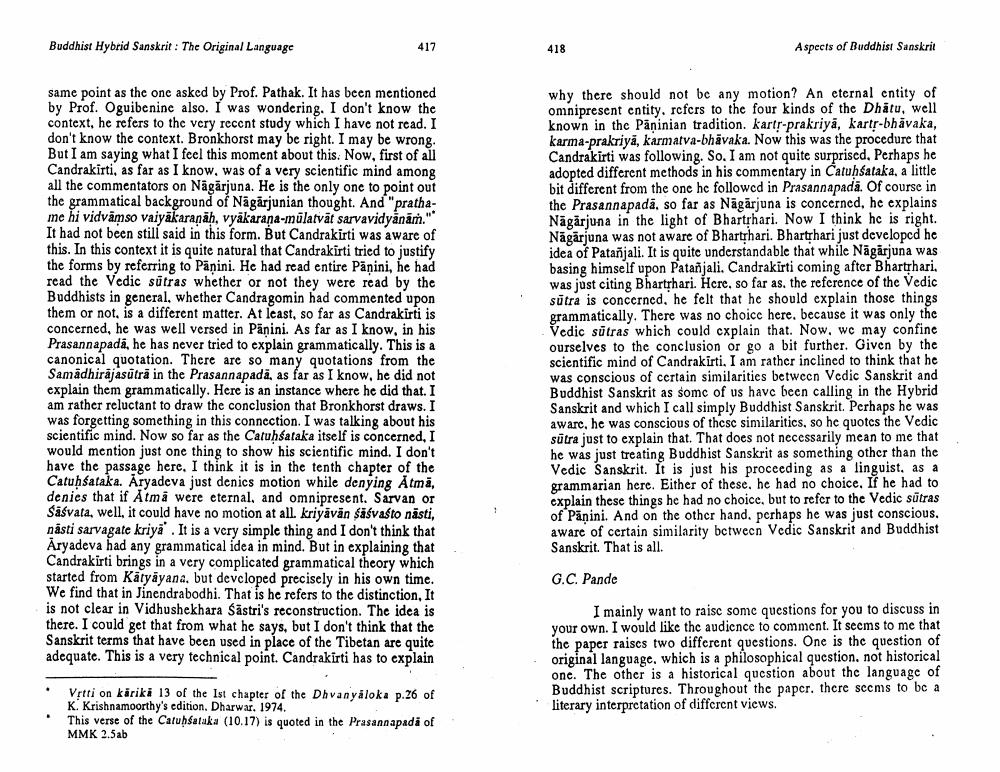________________
Buddhist Hybrid Sanskrit: The Original Language
417
418
Aspects of Buddhist Sanskrit
same point as the one asked by Prof. Pathak. It has been mentioned by Prof. Oguibcnine also. I was wondering. I don't know the context, he refers to the very recent study which I have not read. I don't know the context. Bronkhorst may be right. I may be wrong But I am saying what I feel this moment about this. Now, first of all Candrakirti, as far as I know, was of a very scientific mind among all the commentators on Nagarjuna. He is the only one to point out the grammatical background of Nagarjunian thought. And "prathame hi vidvāmso vaiyakaranah, vyakarana-
mülatvat sarvavidyana." It had not been still said in this form. But Candrakirti was aware of this. In this context it is quite natural that Candrakirti tried to justify the forms by referring to Panini. He had read entire Panini, he had read the Vedic sūtras whether or not they were read by the Buddhists in general, whether Candragomin had commented upon them or not, is a different matter. At least, so far as Candrakirti is concerned, he was well versed in Panini. As far as I know, in his Prasannapadá, he has never tried to explain grammatically. This is a canonical quotation. There are so many quotations from the Samadhirajasūtra in the Prasannapadá, as far as I know, he did not explain them grammatically. Here is an instance where he did that. I am rather reluctant to draw the conclusion that Bronkhorst draws. I was forgetting something in this connection. I was talking about his scientific mind. Now so far as the Catuhfataka itself is concerned, I would mention just one thing to show his scientific mind. I don't have the passage here. I think it is in the tenth chapter of the Catuhsataka. Aryadeva just denics motion while denying Atma. denies that if Atma were eternal, and omnipresent. Sarvan or Saśvata, well, it could have no motion at all. kriyavän säśvasto násti, násti sarvagate kriya. It is a very simple thing and I don't think that Aryadeva had any grammatical idea in mind. But Candrakirti brings in a very complicated grammatical theory which started from Katyāyana, but developed precisely in his own time. We find that in Jinendrabodhi. That is he refers to the distinction. It is not clear in Vidhushekhara Sastri's reconstruction. The idea is there. I could get that from what he says, but I don't think that the Sanskrit terms that have been used in place of the Tibetan are quite adequate. This is a very technical point. Candrakirti has to explain
why there should not be any motion? An eternal entity of omnipresent entity, refers to the four kinds of the Dhatu, well known in the Paņinian tradition. karts-prakriya, kartr-bhavaka, karma-prakriya, karmatva-bhavaka. Now this was the procedure that Candrakirti was following. So. I am not quite surprised. Perhaps he adopted different methods in his commentary in Catuhśataka, a little bit different from the one he followed in Prasannapada. Of course in the Prasannapadã, so far as Nagarjuna is concerned, he explains Nägarjuna in the light of Bhartrhari. Now I think he is right. Nägarjuna was not aware of Bharthari. Bharthari just developed he idea of Patanjali. It is quite understandable that while Nagarjuna was basing himself upon Patanjali. Candrakirti coming after Bharthari. was just citing Bharthari. Here, so far as the reference of the Vedic sutra is concerned, he felt that he should explain those things grammatically. There was no choice here, because it was only the Vedic sūtras which could explain that. Now, we may confine ourselves to the conclusion or go a bit further. Given by the scientific mind of Candrakirti, I am rather inclined to think that he was conscious of certain similarities between Vcdic Sanskrit and Buddhist Sanskrit as some of us have been calling in the Hybrid Sanskrit and which I call simply Buddhist Sanskrit. Perhaps he was aware, he was conscious of these similarities, so he quotes the Vedic sutra just to explain that. That does not necessarily mean to me that he was just treating Buddhist Sanskrit as something other than the Vedic Sanskrit. It is just his proceeding as a linguist, as a grammarian here. Either of these, he had no choice. If he had to explain these things he had no choice, but to refer to the Vedic sūtras of Pånini. And on the other hand, perhaps he was just conscious. aware of certain similarity between Vedic Sanskrit and Buddhist Sanskrit. That is all
G.C. Pande
I mainly want to raise some questions for you to discuss in your own. I would like the audicnce to comment. It seems to me that the paper raises two different questions. One is the question of original language, which is a philosophical question, not historical one. The other is a historical question about the language of Buddhist scriptures. Throughout the paper, there sccms to be a Literary interpretation of different views
Vrtti on kiriki 13 of the Ist chapter of the Dhvanyaloka p.26 of K. Krishnamoorthy's edition. Dharwar. 1974. This verse of the Catuhsalaka (10.17) is quoted in the Prasannapadi of MMK 2.5ab




